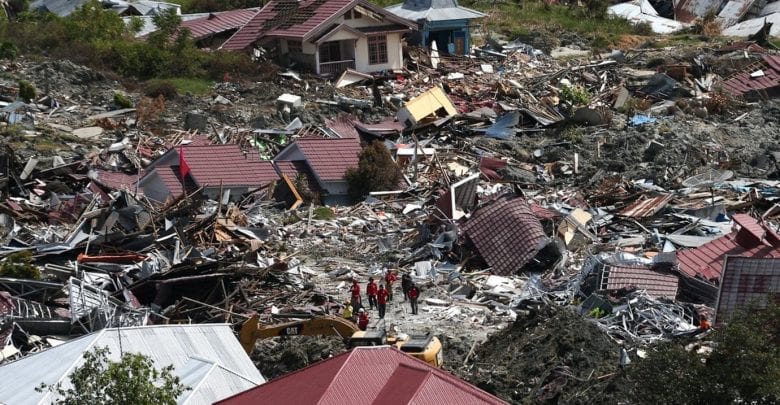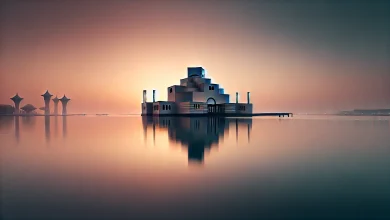
Death toll from earthquake and tsunami in Indonesia nears 2,000
ارتفاع حصيلة ضحايا زلزال وتسونامي إندونيسيا إلى 2000 قتيل
When the violent shaking from a massive magnitude 7.5 earthquake finally stopped, Selvi Susanti stood up and realized something strange was happening. First, she saw the ground suddenly begin to sink. Then the pavement split beneath her feet like a broken dinner plate and started to rise.
Terrified, she clung to a small sliver of asphalt and surfed a river of fast-moving mud as it swallowed entire neighborhoods, carrying her higher than coconut trees for a quarter of a mile.
“What I saw — oh my God! Houses were tumbling. They started to roll like waves. It’s like a tsunami, but the difference was they were waves of soil,” said Susanti, 38, weeping at the memory of seeing so many people simply disappear into the earth as they screamed for help. “It felt like I was in a boat, moving around. But the difference is I was not in water, but in the mud.”
Many, like Susanti in the devastated village of Petobo, had no idea they were in an area already identified by the government as a high-risk zone for the devastating geological phenomenon that causes soft ground to liquefy during earthquakes.
But Indonesian scientist Gegar Prasetya wasn’t surprised by any of the events that occurred at dusk on Sept. 28, killing nearly 2,000 people and leaving possibly thousands more missing. He had warned people for years that the area around Sulawesi island’s Palu Bay had been struck before and was due for another potential combination of factors to create a perfect storm capable of unleashing earthquakes, landslides, tsunami waves and soil liquefaction.
“I knew right away,” said Prasetya, co-founder of the Tsunami Research Center Indonesia, who had met with government officials and residents in the area to try to raise awareness about the threat. “I posted in our group, and I said, ‘It’s happened.'”
Disaster-prone Indonesia, part of the Pacific Basin’s “Ring of Fire,” is an archipelago of about 17,000 islands sitting atop numerous fault lines that have produced some of the largest and most deadly earthquakes, tsunamis and volcanic eruptions in recorded history.
Other scientists around the world wondered how this type of earthquake — on a strike-slip fault, which typically does not produce dangerous tsunamis — could generate waves that surged as high as 6 meters (20 feet).
Again, Prasetya knew.
He had published a paper nearly two decades ago highlighting six other tsunamis recorded in the Makassar Strait in the past century, predicting that a repeat event could be expected roughly every 25 years. The last one occurred in a region north of the city in 1996. Before that, Palu Bay was hit in 1968 by a very similar magnitude 7.4 quake that generated waves 10 meters (33 feet) high.
“This one complete village went to the sea,” he said of the 1968 event. “You can still see the trees from the top of the water.”
Some experts theorize that the Sept. 28 quake, by itself, didn’t generate a big wave despite being shallow and near the coast. They’re convinced it was instead the area’s soft soil that served as the real catalyst for disaster. The temblor’s long, violent shaking likely triggered one or more underwater landslides due to unstable sediment deposited on the seafloor by rivers. This disruptive movement may have created the large wall of water that raced across the open ocean until being squeezed into the long, narrow bay that surrounds Palu, forcing the wave to grow higher.
“Imagine what happens if you drop a brick in a flat pond — ripples spread in all directions,” said Robert Hall, a geologist at Royal Holloway University of London, who has studied the area. “Now drop the same size object in a bathtub. The waves can reflect off the sides, can amplify, and may get larger in the direction of the length of the bath.”
But it wasn’t just weak sediment in the ocean that gave way. Wet, sandy soil also separated and came alive through liquefaction in some areas due to the earthquake’s radical vibrations. The ground simply lost its strength and turned to mush beneath people’s feet, creating mud that acted like quicksand. People, houses, cars and streets were swallowed and covered by a thick carpet of what — just seconds earlier — had been solid earth. Fast-moving landslides also were launched above ground, possibly causing even more localized tsunami waves.
“We wouldn’t necessarily expect to get all the worst possible factors occurring together,” said Willem De Lange, a scientist from the University of Waikato in New Zealand who co-authored research on the area with Prasetya in 2001. “Unfortunately this does happen.”
Many questions remain about exactly what happened in this complex disaster. Prasetya will begin field work with the Indonesian navy this week to try to better understand what occurred under water, and a team of international experts are expected to arrive next month to carry out an assessment.
Palu’s population has exploded in many high-risk areas since the 1968 event, which killed 200 people and also turned soil to mud in places, leaving many newcomers vulnerable with no local history.
However, the central government did produce a map in 2012 identifying large swaths of Palu, a city of 380,000 people, where liquefaction could occur. The area of Petobo, for instance, was classified as having high-risk potential. The report also recommended that housing and industrial areas should best be built in areas with low liquefaction risk. It suggested mitigation efforts, including building structures with deep foundations anchored into firmer layers of earth.
Good urban planning is ultimately the key to saving lives, said Sri Hidayati, head of earthquake mitigation at the Energy Ministry’s Geology Agency, which produced the report that was shared with the provincial and district governments in Sulawesi. She said it’s her agency’s responsibility to provide the mapping, but it’s up to local authorities to “use it or not.” Calls Monday to Palu’s vice mayor and the mayor’s aid went unanswered.
“If everything in the future is planned based on this, I think maybe we will only experience a small number of casualties in case such a disaster occurs again,” she said. “Or probably no casualties at all.”
At a news conference in Jakarta on Monday, the head of the country’s disaster agency also confirmed that soft soil areas in Palu are not fit for housing.
“It is impossible to rebuild in areas with high liquefaction risk such as Petobo and Balaroa,” he said, adding that people still living there will be relocated.
Indonesia has been criticized for lifting the tsunami warning it issued for Sulawesi’s coast too soon. The earthquake knocked out power and telecommunication towers, meaning sirens didn’t wail and alerts didn’t light up mobile phones. Online video showed an unsettling scene as cars and motorbikes drove at normal speeds on a coastal road and oblivious people milled about on the beach while the large, fast-moving wave could be seen racing closer before exploding onshore.
“It’s almost impossible for a tsunami warning system to predict what we saw the other day,” said Adam Switzer, a tsunami expert at the Earth Observatory of Singapore. “The earthquake is the warning. If you’re anywhere in southeast Asia and you’re on the coast and you feel an earthquake, move inland and move to higher ground and stay there.”
But it’s also not a matter of only warning people just before something happens. Prasetya said the history and geology of Palu Bay must be considered in plans to rebuild. He said soil investigations should be carried out to determine if deep piles are needed to stabilize buildings. Local knowledge should also be considered as a cheap way to save lives, such as constructing houses out of wood with thatched roofs, instead of concrete and tile.
In Petobo, tsunami warnings would not have helped because there was no time to respond. All that remains of the village, located about 30 minutes from the center of Palu, is a muddy wasteland where only the very tips of roofs remain above ground in places. Satellite images show a heavily populated area stretching more than 250 acres being devoured by what looks like a giant layer of chocolate milk. In mobile phone videos, buildings are seen sliding like pucks across a slab of ice. Some people spent hours trying to find their homes after the disaster, locating them about 1.2 miles from where they once stood.
“It felt like we were spinning in a blender,” recalled Susanti, who survived by leaping to solid ground and running after the mud flow finally slowed down. “I saw houses change position. Houses which were located at the east moved to the west and vice versa. I saw the twisted mud was shaped like dough.”
Recovering bodies from Petobo and other hard-hit areas, such as Balaroa, has been difficult because heavy equipment will sink in the soft soil and is unusable there. The government is considering turning some of these sites into mass graves, according to Wiranto, Indonesia’s security minister, who uses one name.
“It is already a ghost village. I will not go back there even if they pay me 1 billion rupiah ($65,800),” said Erli Yati, 32, who also survived what’s been dubbed a “land tsunami” by some in Petobo.
She had no idea about the previous disasters there or that the ground could come alive as it did.
“I will not step back to that place again,” she added. “That was the worse experience I have ever had.”
Prasetya commended the idea of closing off liquefaction areas and said mitigation — whether it’s creating and enforcing proper building codes in at-risk zones or relocating people to safer places — should be implemented before the next disaster.
“How many souls need to be sacrificed until the government knows mitigation is important?” he asked, adding he’s been sounding alarms since the massive 2004 earthquake-spawned tsunami off Sumatra island killed 230,000 people in a dozen nations, more than half of them in Indonesia. “Everything is back to business as usual.”
source: chicagotribune.com
أعلنت السلطات الإندونيسية اليوم ارتفاع حصيلة ضحايا الزلزال وموجات المد العاتية تسونامي التي ضربت جزيرة سولاويسي الإندونيسية الأسبوع الماضي إلى نحو ألفي قتيل، كما لا يزال آلاف الأشخاص في عداد المفقودين.
وذكرت السلطات الإندونيسية ،في بيان لها، أنه تم العثور على 1944 جثة في مدينة بالو وضواحيها التي ضربها زلزال بقوة 7,5 درجة على مقياس ريختر تبعته أمواج قوية في 28 سبتمبر الماضي.
وفي سياق متصل، قال السيد محمد توهير الناطق باسم الجيش الإندونيسي إن هذا الرقم يمكن أن يرتفع أكثر لأنه لم نتلق بعد، الأمر بوقف أعمال البحث عن جثث الضحايا.
وتخشى السلطات الإندونيسية أن يكون هناك نحو خمسة آلاف مفقود، يحتمل أنهم تحت الانقاض، حيث لم يعد هناك أمل بالعثور على ناجين فيما تتركز الجهود حاليا على انتشال الجثث وأعدادها.
وكانت الكارثة الطبيعية في إندونيسيا أجبرت عشرات الآلاف من السكان على الإجلاء عن منازلهم والذهاب إلى مخيمات إيواء مؤقتة، ويعاني الكثير منهم من عدم توافر جميع الاحتياجات الأساسية.



